You may have heard this story before. In the 1970s there was an Eastern Bloc gymnast who was a highly acclaimed child prodigy, rose to prominence after scoring a Perfect 10, and went to the Olympics when she was 14 years old. This may sound like the story of a Romanian named Nadia, but the gymnast I am describing is a Soviet named Nina.
Nina Dronova first appeared in 1970 where she was entered into a series of high level junior level competitions at 12 years of age. Amongst the competitions was Druzhba which was the top international competition for juniors of the era. The Soviet delegation was led by the 16 year old Rusudan Sikharulidze and a pair of 15 year olds by the names of Tamara Lazakovich and Olga Korbut.

The trio of older veterans (relative to the junior level) took the top three spots, but coming up in 4th place was the significantly younger Nina Dronova. In Event Finals (EF) Dronova won the gold medal on bars. In doing so she not only beat out the legendary Korbut, but the equally talented Tamara Lazakovich as well.
Not as well known because her career was cut short by injury, in her heyday Tamara Lazakovich was winning medals at a rate comparable to Korbut. The following year Lazakovich tied Ludmilla Turischeva for the All-Around (AA) title at the 1971 European Championships. The result effectively made her the top ranked gymnast of the year.
Despite not winning the AA at Druzhba, the young Dronova had demonstrated a degree of prowess against two gymnasts who were on the verge of becoming the best in the world. And then there was Rusudan Sikharulidze who also lost to Dronova at the 1970 Druzhba bar finals. Like Sikharulidze, Nina Dronova also came from the Soviet Republic of Georgia. The two Georgian gymnasts would compete in a dual meet between Georgia and Hungary.
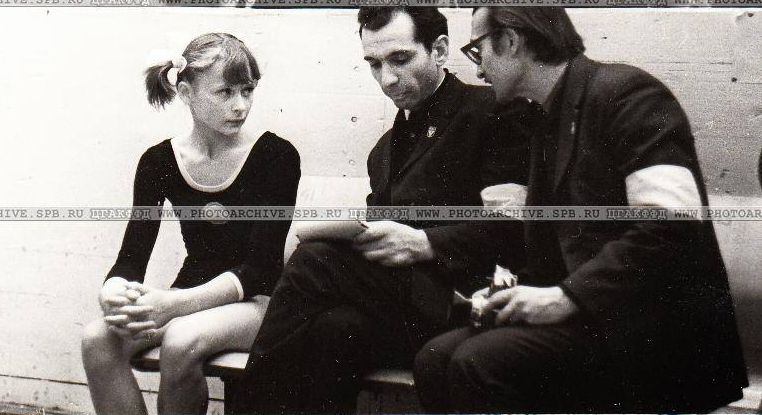
At that competition Dronova beat out Sikharulidze for the highest score. Dronova didn’t just win, the margin of victory (MOV) between 1st and 2nd was roughly the same as the MOV between 2nd and 6th place. With a second strong competition under her belt, neither performance could be dismissed as a fluke. At the 1970 USSR Championships Sikharulidze placed 7th in the AA. By beating Sikharulidze, it was now clear that the 12 year old Dronova was in the realm of contending for a spot on the Soviet A-Team.
In 1971 Dronova not only improved, she significantly upped the ante. She once again took 1st place in a dual meet against Hungary while Sikharulidze finished second. In a dual meet against Japan Dronova failed to record the highest score, but she had kept pace with Ludmilla Turischeva and Olga Korbut. In doing so Dronova could no longer be described as a fringe member of the Soviet A-Team, at 13 years old Nina was now one of its strongest members.
At the junior level Dronova predictably walloped the international field on her return to Druzhba in 1971. Dronova won the AA and recorded three gold medals with a second place finish on vault during Event Finals. Dronova attended the 1971 Riga International which featured a particularly strong field. Of the ten highest scoring gymnasts in the AA, eight of them would compete at the 1972 Olympics. Among them, the previously mentioned Tamara Lazakovich.

Dronova appeared to have held her own against all of them, but a disastrous floor routine demoted her to fifth place. If not for her poor performance on floor, Dronova would have placed no worse than silver and had a realistic chance of taking the AA gold for herself. In Event Finals Dronova won two gold medals plus a silver on vault and was the only gymnast with two gold medals in EF. It was perhaps a declaration that the 13 year old child prodigy truly was the best gymnast in attendance in a competition loaded with established veterans.
It is interesting to note that in the AA, Dronova recorded a higher score on beam than the American Cathy Rigby, a veteran of the 1968 Olympics and the reigning silver medalist on beam at the World Championships. Dronova also won a gold medal on floor in EF which was the same apparatus that had doomed her in the AA, effectively proving she truly was the most capable gymnast across all four events.
But the most absurd result Dronova produced in 1971 came at the Chunichi Cup in which she beat both Olga Korbut and Ludmilla Turischeva for the AA title. Dronova didn’t win because Korbut and Turischeva fell, Nina outperformed them all across the board. Turischeva recorded a higher score than Dronova on just one apparatus while Korbut recorded a lower score than Dronova on every apparatus. This same competition also featured two American gymnasts who would soon be named to the 1972 Olympic team. Another participant was Zinaida Voronina who took silver in the AA just three years prior at the 1968 Olympics and was the highest ranking returning Olympian of the quad.

But none of these competitions would be Nina’s defining moment of 1971. It was her performance at the 1971 USSR Spartakiade that made her a legend. Dronova was relegated to the junior division and would only be facing juniors from within the Soviet Union. For a gymnast who was now capable of beating the very best seniors in international competition, it was a complete mismatch.
It wasn’t that Dronova won this competition, it was the extent at which she had massacred the opposing competitive field that made international headlines. As pointed out by Gymn-Forum, Dronova’s winning score was higher than that of Tamara Lazakovich who won the senior division of the same competition. Amongst juniors, Dronova won a gold medal on every event. But the accomplishment that generated the most attention was what Dronova did on floor.
She scored a Perfect 10.
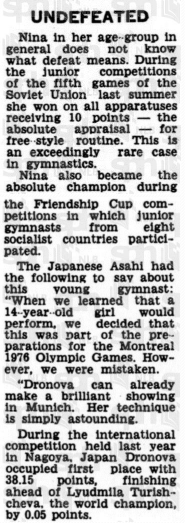
Five years before Nadia made her mark at the 1976 Olympics, Nina was receiving international media coverage for scoring a Perfect 10 as well. In the pre-Nadia era it was incredibly rare for a gymnast to score a Perfect 10, and a gymnast doing it in a competition prestigious enough to receive international press attention was even rarer. Vera Caslavska who has a career resume which rivals that of Simone Biles is the only other gymnast to receive such attention for a Perfect 10 in this particular era.
In one article clipping Nina is described as being undefeated in her age group, her wins over Turischeva (the reigning AA Champion at the World Championships) and Druzhba (Friendship) are also noted. It continues by describing her winning a gold medal on every event and noted the significance of her Perfect 10. Humorously, the clipping describes the Japanese being bewildered as they were expecting a gymnast of that age to be on a trajectory for the 1976 Olympics, but was actually being prepped for the 1972 Olympics. The full article can be found here.
This would mark only the very beginning of Dronova making a string of appearances in various forms of media. Dronova is incredibly well documented for the era with a gallery of available pictures in various archives that rivals only those who went on to become future members of the International Gymnastics Hall of Fame. Dronova appears to be the earliest example of a Soviet gymnast being widely photographed at just 11 and 12 years old.
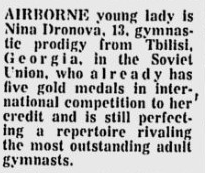
Dronova’s image even made its way to the United States. She appears to have been entered into a press wire service. Newspaper editors who needed to fill empty column space would select pictures/articles from that press wire service to fill it, and at times they chose a picture of Dronova with a small single-paragraph article attached to it. The brief article would specifically describe her as rivaling the best gymnasts of the world. Back in 1971 and a full year before “Korbut-mania” had reached the United States, Nina Dronova was appearing in the newspapers of small American cities all over the country.
As a gymnast who had competed in Japan, Dronova’s presence can be seen in that country as well. Dronova also received coverage in Japanese gymnastics media. At the time Japan had 50% of the population of the United States and a strong gymnastics culture. Thus making it a major market for Soviet gymnastics.
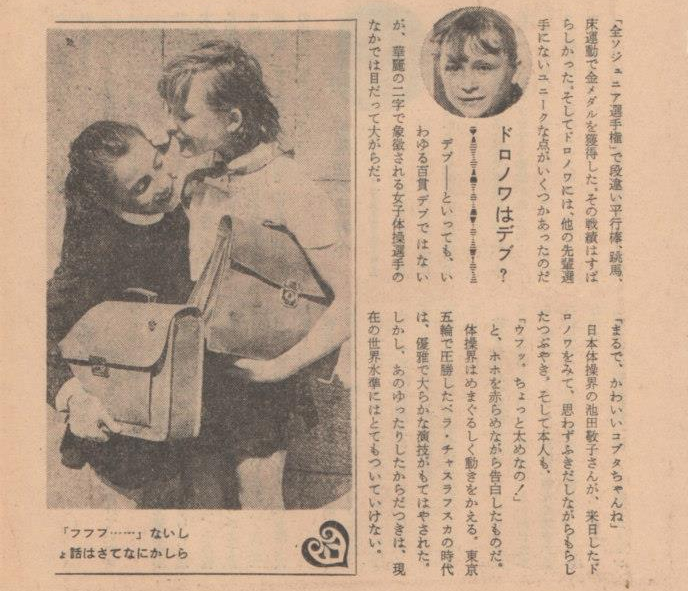
Part of what made Dronova such a favorite amongst photographers and newspaper editors was her natural ability to smile. She knew how to interact with the camera and could produce the most wholesome smile. Dronova didn’t just know how to pose for photographers, some of the best shots taken of Dronova were not staged but spontaneous moments. Like Olga Korbut, the moments and especially the smiles were just a part of her natural personality.

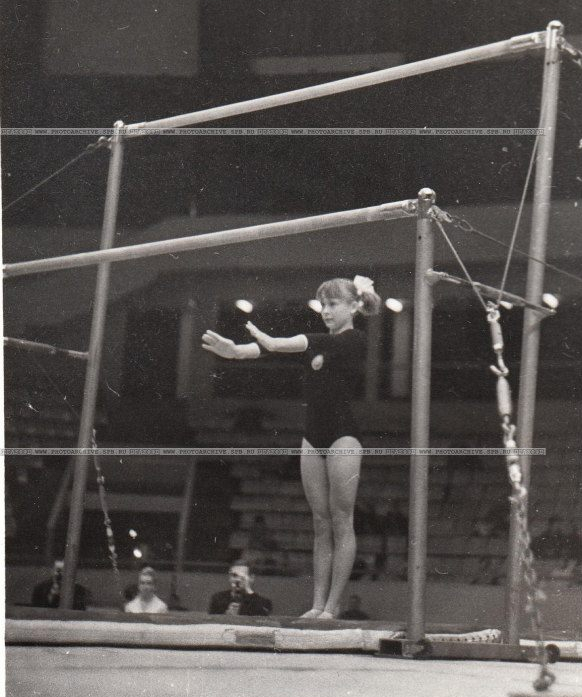
Dronova also had an advantage when it came to her small physical stature. During the age of Nadia and Korbut it quickly became apparent to administrators and media members that youth sells. Young gymnasts were inherently more popular than their older counterparts and gymnasts who could project a youthful appearance could provoke a larger response from fans.
But Dronova’s media presence was more than mere pictures, there is plenty of footage to go along with it. Soviet highlight reels would often capture top Soviet gymnasts from competitions, of which Dronova was a part of. But in one instance a Soviet camera crew had gone directly to Dronova’s gym which rarely happened to even their top-ranked gymnasts of the 1969-1972 quad, let alone a gymnast who was only 13 years old.
While watching the above footage you will notice that Dronova has the tendency to cry frequently while on camera. This would be a theme both inside the gym and during actual competitions for everyone to see. Dronova didn’t achieve high levels of success without blood, sweat, and tears. When she was down, she expressed it via her sad demeanor. But when things were going well for Dronova, she expressed those feelings as well.
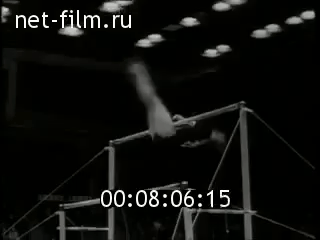
When Dronova stuck her dismount she ran back to the sideline looking as if she could barely contain her excitement. The significance of this footage is that Olga Korbut did the exact same thing at the 1972 Olympics and it was treated as a breakthrough moment for the sport. It is often seen as a key reason why fans fell in love with Olga Korbut as it provided a more humanizing view of Soviet gymnasts and deviated from what Western audiences were expecting out of Soviet athletes. Yet one year earlier the exact same trait was seen in Nina Dronova.
Dronova even made a brief appearance in a major-motion picture by the name of Sport, Sport, Sport. The movie itself can be described as nothing other than bizarre, and I would even recommend a gore warning (starting at 2:27 of the clip below). Dronova was one of 16 actors credited in the film and as a result, she has her own IMDb page. Her appearance in this movie came at a time in which she was only 12 years old, but by then she already had an established reputation and according to Gymn-forum, had made a list of top-10 athletes from the Soviet Republic of Georgia.
At this point everything that has happened so far occurred before 1972. In 1972 Nina Dronova was going to be 14 years old and it would be an Olympic year.
Dronova would ultimately miss the 1972 Olympics despite being named to the original team with some sources claiming injury, others claiming a bout of food poisoning. Adding an extra twist to the story, Dronova’s replacement is widely believed to have been Olga Korbut and Dronova herself participated in podium training despite assertions that she was unwell. These details have led to speculation that political considerations had dominated the team selection process and it is an extremely controversial moment in Women’s Artistic Gymnastics (WAG) history. I’m going to move on because this topic really deserves its own article to discuss it properly. But I will say the following:
Dronova missed a string of competitions in early 1972 giving credence to the notion that she was dealing with an injury of some kind. If that is the case, Dronova can be described as the most heartbreaking example of a gymnast who was destined to dominate an Olympic games only to miss the competition altogether due to injury. Not only is this perhaps the most heartbreaking injury in WAG history, it is certainly its most pivotal.
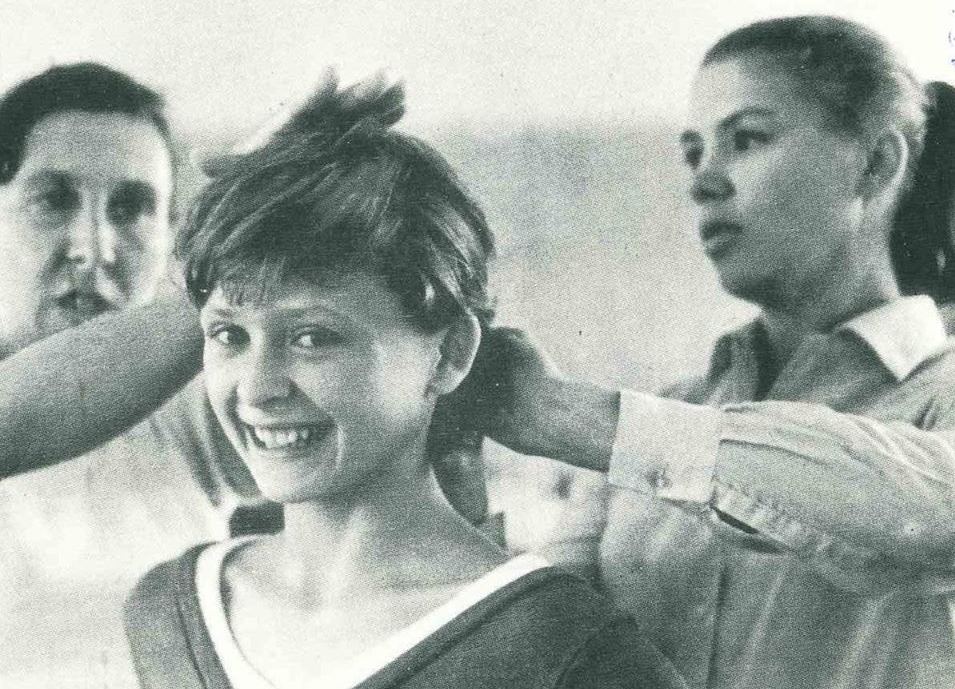
The downfall of Nina Dronova is intertwined with the rise of Olga Korbut. Had Dronova competed at the 1972 Olympics, WAG history would look very different. Perhaps for the better, perhaps for the worst. As for what would have happened had Dronova competed at the 1972 Olympics, there is one result that gives us insight as to what could have been.
Later that year Dronova reappeared at the 1972 Chunichi Cup where she was joined by Turischeva and Karin Janz. The two gymnasts had finished first and second in the AA at the 1972 Olympics. Dronova finished second beating Turischeva, but losing to Karin Janz. It was Dronova’s final statement that she would have been a major factor as a 14 year old at the 1972 Olympics. Unlike the 1971 Chunichi Cup where Dronova trounced all over Turischeva, in 1972 it was an evenly matched battle. It was the first sign that Dronova was starting to decline, of which she eventually did. Dronova remained a figure on the Soviet team over the next four years, but only in a minor role. Dronova’s window of opportunity had come and gone.
Nadia Comaneci in 1976 is often attributed to being the gymnast responsible for causing the ages of WAG to plummet. But an analysis of the data reveals that most of the decline actually predates Nadia. At the 1972 Olympics eight different teams had a 14 year old in their lineup. If Dronova was the Nadia before Nadia, she was also the Korbut before Korbut.

Olga Korbut is frequently attributed to have single-handedly popularized the sport at the 1972 Olympics, but WAG was experiencing a popularity surge going back to the 1960s. Shortly before the 1972 Olympics Cathy Rigby was featured on the cover of Life Magazine. Proving that even before Korbut’s breakout success, WAG was already receiving top billing in the media. It was also a few months before the 1972 Olympics and Korbut’s breakout success that the New York Times wrote about WAG’s “soaring” popularity.
None of this is to tear down Olga Korbut as Korbut without question is responsible for drastically increasing the popularity of the sport. What gets overlooked though is the popularity WAG already had and how that aided Korbut’s historic rise. It was gymnasts who appeared on the scene just before the 1972 Olympics like Dronova that gave Korbut the foundation to become WAG’s first superstar. Only by acknowledging the existence of this pre-Korbut popularity trend can it be understood how Dronova was featured in American newspapers before Korbut’s breakout 1972 performance.
If Dronova has similarities to Olga Korbut, she is a full fledged clone of Nadia Comaneci. Dronova was the first example of a gymnast successfully competing against established seniors at such a young age. She was the first gymnast to truly be treated like a child prodigy by the media and the first to project the same image that Nadia would later project in 1976.
One of the many paradoxes of Nina Dronova is that she started her career being a novel style of a gymnast and was very much the first of her kind. But by 1972 Dronova had evolved into a classical style gymnast who could have passed for a younger version of Turischeva. Dronova possessed the same personality traits as Korbut that were critical to Olga winning over the hearts of the Munich spectators. But Dronova did not provide a new dimension to the sport which was the other aspect to Olga Korbut that made her so thrilling.
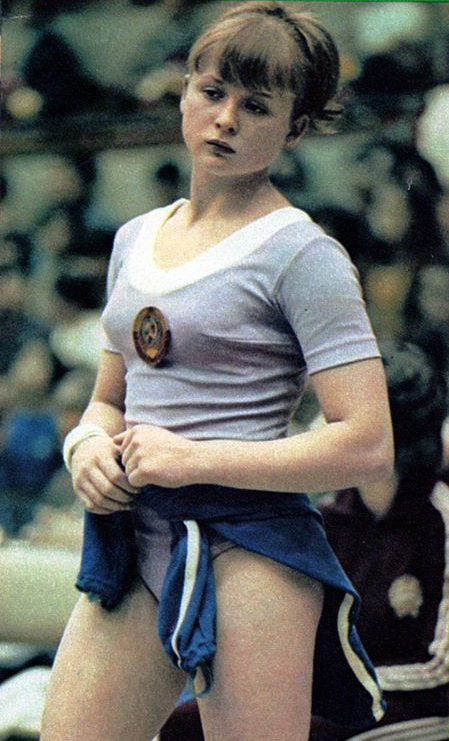
But most importantly, Olga Korbut prevailed as a dominating gymnast at the senior level whereas Dronova did not. Dronova didn’t fail as a senior due to a lack of talent, but having a body type that was quickly becoming obsolete as the sport was pivoting towards a new style of gymnast. In the end Korbut was simply the better candidate to be WAG’s first superstar.
This is the other paradox involving Nina Dronova. When it comes to legends such as Vanessa Atler and Olga Mostepanova, fans express remorse over the misfortune that prevented them from achieving their Olympic dream. But in the case of Nina Dronova, how does a fan do that when knowing an alternate timeline where Dronova has Olympic success is a timeline where Korbut and the popularity she brought to the sport never happens?

There is so much to discuss when it comes to Nina Dronova and this will not be the last time I dedicate a major article to her. There are so many aspects to Nina’s story that I can’t fit them into a single biographical feature piece. But I will finish this article with two pictures. The first picture is from the official magazine of the American gymnastics program. Published shortly before Nadia’s breakout success at the European Championships in early 1975, it was a ranking of the best WAGs of the 1974 season. Note who finished one spot above Nadia. The second picture answers a question you are probably asking yourself. Did the “Nadia before Nadia” ever cross paths with THE Nadia?
Yes, they did.
Another crazy twist to this story is that Nina Dronova was having success at such a young age that she is still young enough to compete in junior competition even after the 1972 Olympics. Below is a picture of 1973 Druzhba. On the right is Bela Karolyi. In front of him are the gymnasts of the Romanian delegation wearing their white leotards. Second in the lineup order is Teodora Ungureanu and behind her is Nadia Comaneci. At the very top of the picture and next to the North Korean flag is Nina Dronova.

Nadia and Nina actually shared two podiums (vault and floor) at this competition. Even though Dronova had won some medals, it was at this particular competition that it became evident Dronova was no longer going to be in a position to challenge the very best gymnasts in the world. This picture is incredibly historic. It represents the passing of the torch from one of the finest child prodigies WAG had ever seen, and to a new one who would become even greater.

